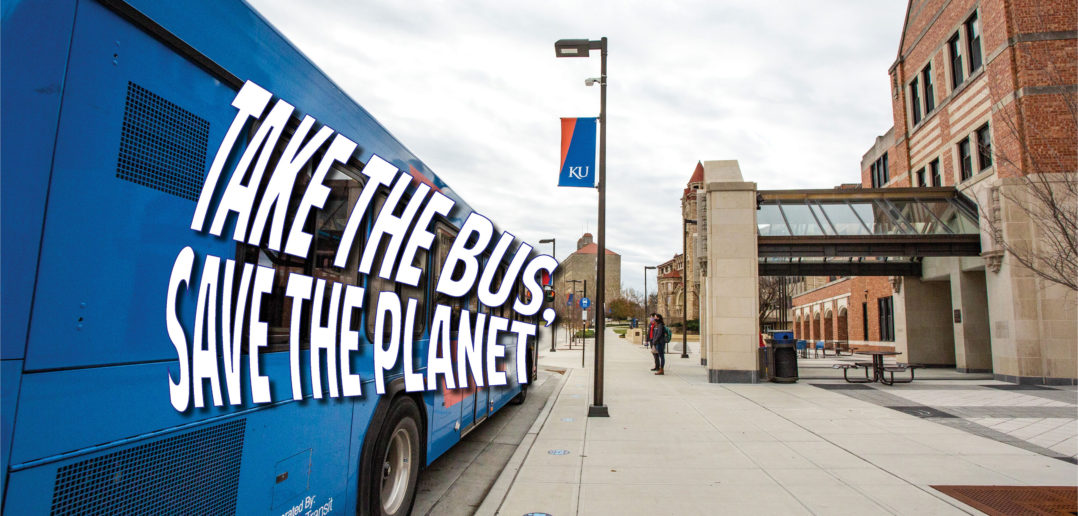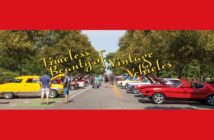| story by | |
| photos by | Steven Hertzog |
These new City projects will help propel Lawrence into the future of environmental sustainability.
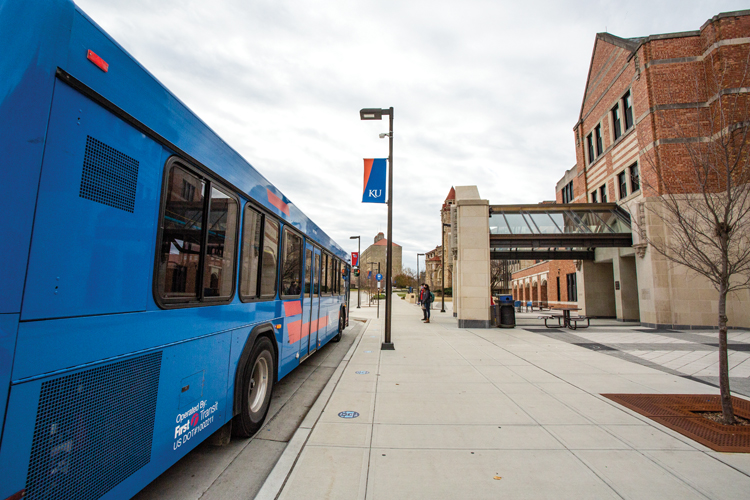
Take the Bus, Save the Planet
Lawrence’s transit system is going places, specifically into the next generation of transit and sustainability. In fact, by fall 2022, Lawrence is going to have a brand-new multimodal transfer facility, newly redesigned bus routes and five new fully electric buses in service. These three projects all contribute to Lawrence Transit’s efforts to become more environmentally sustainable.
Since 2006, the City of Lawrence and the University of Kansas (KU) have worked together to coordinate public transit services. This relationship has been fruitful. Not only do KU students ride the buses, but school-aged children, parents, the elderly and many others utilize Lawrence’s transit system. In 2019, the City of Lawrence and the University of Kansas provided 2.98 million rides. One of those riders, Charlesia McKinney, a student working toward her Ph.D. and graduate teaching assistant for the English Department, relies heavily on Lawrence’s bus system to get back and forth from home to campus. “I’ve relied on the bus to get to campus since 2014. It’s about 10 minutes to campus from my apartment, which is so convenient as a student and teacher. I’m glad it’s an option.”
Lawrence Transit is supported by the committed work of approximately 120 drivers. While around 46 of these drivers are responsible for KU-funded routes, Aaron Quisenberry, associate director of Transportation Services at KU, notes that all the drivers are cross-trained to drive all routes and can choose to drive either KU or city routes each time they are up for bid.
During maximum service, Lawrence Transit has 40 buses in service plus 20 smaller, paratransit vehicles for things like medical transport. Adam Weigel, transit and parking manager for the City of Lawrence, says city buses are financed through a combination of local sales tax, federal funds and grants, which help keep costs down for your everyday rider.
The University owns 42 buses, and 24 to 27 of them provide regular service at any given time. Quisenberry explains that KU buses are financed through required student campus fees and campus parking permit dollars, which supplement the difference between the fees and the cost of the buses.
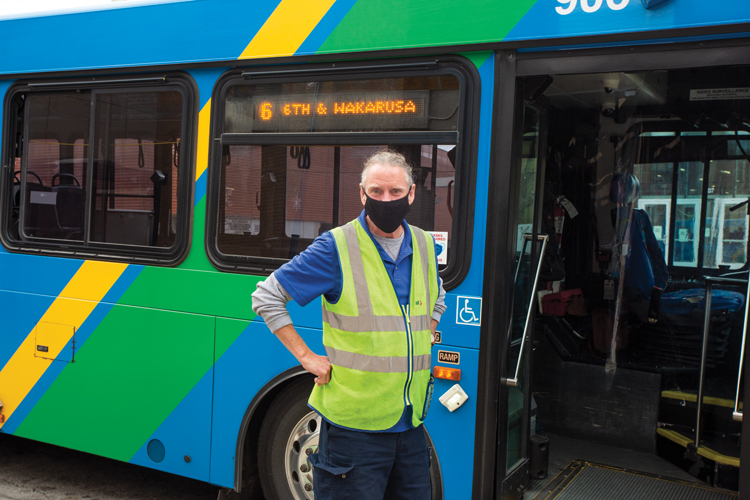
Retired school teacher Steve Pierce, now drives a city bus for Lawrence Transit
New Multimodal Transfer Facility Project
Over a decade ago, Lawrence Transit and the Lawrence community began studying, discussing and debating a permanent location for the primary bus transfer facility. McKinney was happy to hear about the new bus transfer facility: “I’ve always been proud of Lawrence’s public transit system—I’m delighted to hear they’re expanding the bus system.” According to lawrencetransit.org, “In July 2020, the City and the University of Kansas signed a legal agreement to move forward with further study and development of a multimodal transfer facility on university property located at Bob Billings and Crestline Drive. This location takes into account community feedback from prior studies that sought a relatively central location and one that did not encroach on established neighborhoods.”
However, some residents have expressed concern about the new location. Regular bus rider Lochi Sampson, for example, notes the current hub location downtown is more accessible, “especially for homeless people who spend most of their time downtown. Moving it into that area would probably make things more difficult for them.” Others, however, see potential in the hub’s new location. Local resident Stefanie Torres-Maksimowicz says, “It’s great. A lot of upperclassmen live over in that area, so that will help getting them to campus. It being central for locals will help with getting around to the edge of town.”
In fact, a new bus route system could work to mitigate some of the issues Sampson worries the homeless might experience with the new hub, since the new homeless shelter is now on the edge of town.
Though “preliminary design work may commence as soon as this winter, construction will not begin until late 2021”, Quisenberry notes. “The target opening date for the new bus transfer facility will be August 2022.”
For more information about the Multimodal Transfer Facility Project, visit: lawrencetransit.org/transfer-facility.
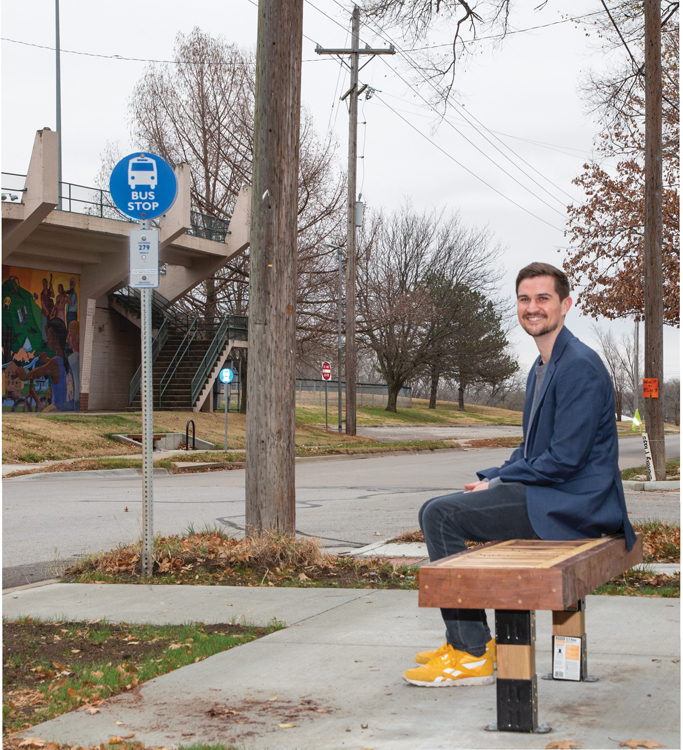
Waiting for a bus in east Lawrence, Adam Weigel comfortably sits on a new Transit bench
Route Redesign
The new location of the transfer facility will no doubt impact current bus routing. Sampson explains: “If they have no way of consulting the people who rely on the buses the most, then changing the routes is generally a bad idea.” Fortunately, both the City and KU recognize that any change to bus routes will affect riders in any number of ways. Thus, input from the Lawrence community is sought during this process. During the next year, the City will collaborate with the community to determine a new route structure for transit. According to lawrencetransit.org, “Following these route redesign processes, the design process for the facility itself will begin. Each route redesign study and the facility design process will include early and substantial public engagement.”
Student input is also essential to the continued success of Lawrence Transit, and students will be asked to provide feedback on route changes. Quisenberry emphasizes, “there will be opportunities for students to give their input on potential future route changes when we have a consultant working on the system/route redesign in spring 2021.”
To provide your input on the Lawrence bus route redesign, please fill out the bus route redesign surveys provided on the City of Lawrence website at lawrenceks.org/listens/surveys.
New Electric Buses
In addition to the new transfer facility and the bus route redesign, Lawrence is also gaining five new ecofriendly buses. In June 2020, Lawrence Transit announced it was a recipient of a $3.75 million grant aimed at helping communities invest in the next generation of bus technology to enhance their transportation systems. The Low- or No-Emission grant program finances the deployment of transit buses and infrastructure for the purchase or lease of zero-emission and low-emission transit buses and supporting facilities. The grant requires a local match of $2.2 million, which the City has already budgeted as part of its commitment to moving toward being almost entirely powered by renewable energy in 2021. Lawrence Transit plans to use these funds to replace five diesel-fueled buses that have exceeded their useful life with five zero-emission battery electric buses. The new electric buses will be used on routes serving the city and the university, and should be in service by fall 2022.
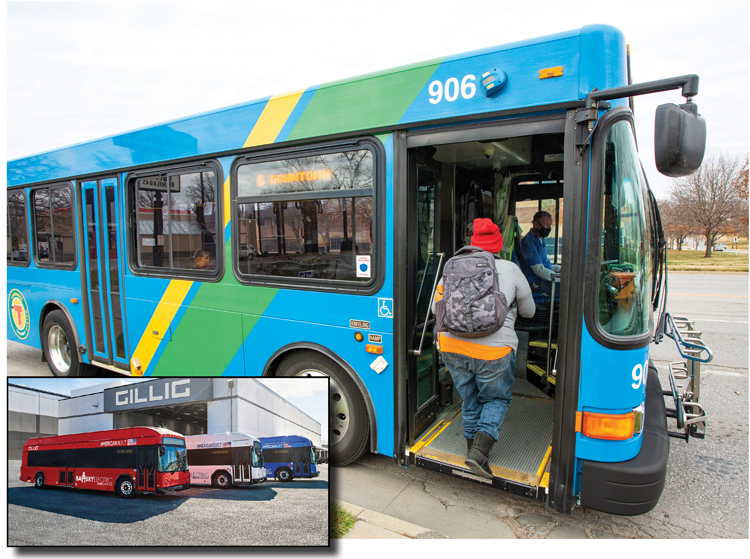
top Steve Pierce lets on a passenger at one of his stops; bottom The new electric buses coming to Lawrence soon
Why Electric Buses?
“I love that they’re adding new electric buses because anything that our little town can do to help the environment is a plus,” exclaims resident Torres-Maksimowicz. In fact, electric buses provide several benefits to their communities and the environment.
They improve air quality because they eliminate diesel exhaust emissions and particulate pollution. They produce significantly lower greenhouse gas emissions than natural gas-powered, diesel or diesel-hybrid buses. (Did you know replacing all the country’s diesel-powered transit buses with electric buses could eliminate more than 2 million tons of greenhouse gas emissions each year?)
They can also deliver financial benefits, including reduced maintenance costs. According to the Environmental and Energy Study Institute, the lower operating costs of electric buses “make them more economical in the long run than internal combustion engine buses. It is about 2.5 times cheaper to power vehicles with electricity rather than diesel, and electricity prices are generally much more stable than gasoline or diesel prices … In addition, maintenance costs for electric motors are much lower because they have far fewer moving parts than conventional motors and are far more efficient.”
They deliver significant societal benefits, as well, including eliminating noxious gases and particulate pollution that is so detrimental to our health, and greenhouse gases that are so harmful to our planet.
Worried about riding during the epidemic?
Lawrence Transit has received federal funding from the CARES Act to help maintain services during COVID-19. Weigel notes the City is using CARES Act dollars to keep up service levels and to ensure that both bus drivers and riders are as safe as possible. It enforces mask compliance and open windows when the weather allows, cleans the buses throughout the day and engages in deep cleans at night. Buses are now also equipped with a barrier separation to reduce contact between the driver and passengers. Buses are only $1 to ride, and students ride free with a KU ID.
![]()

